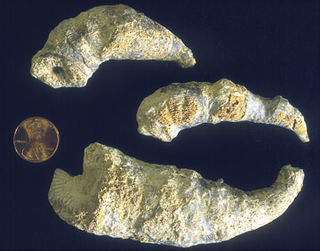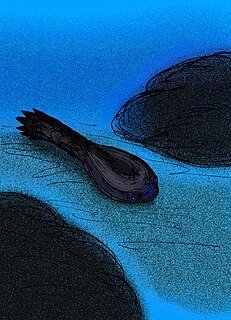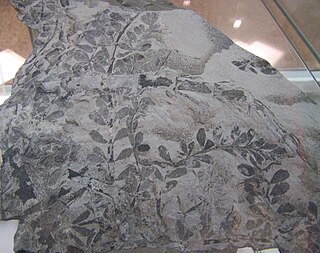 W
WActinocrinites is an extinct genus of crinoids.
 W
WAdelophthalmus is a genus of eurypterid, an extinct group of aquatic arthropods. Fossils of Adelophthalmus have been discovered in deposits ranging in age from the Early Devonian to the Early Permian, which makes it the longest lived of all known eurypterid genera, with a total temporal range of over 120 million years. Adelopthtalmus was the final genus of the Eurypterina suborder of eurypterids and consisted the only known genus of swimming eurypterids from the Middle Devonian until its extinction during the Permian, after which the few surviving eurypterids were all walking forms of the suborder Stylonurina.
 W
WAmmonoids are a group of extinct marine mollusc animals in the subclass Ammonoidea of the class Cephalopoda. These molluscs, commonly referred to as ammonites, are more closely related to living coleoids than they are to shelled nautiloids such as the living Nautilus species. The earliest ammonites appear during the Devonian, and the last species vanished in the Cretaceous–Paleogene extinction event.
 W
WAsteracanthus is an extinct genus of Elasmobranchii.
 W
WBelemnoids are an extinct group of marine cephalopod, very similar in many ways to the modern squid and closely related to the modern cuttlefish. Like them, the belemnoids possessed an ink sac, but, unlike the squid, they possessed ten arms of roughly equal length, and no tentacles. The name "belemnoid" comes from the Greek word βέλεμνον, belemnon meaning "a dart or arrow" and the Greek word είδος, eidos meaning "form".
 W
WCaninia is an extinct genus of rugose coral. Its fossils occur worldwide from the Devonian to the Permian periods.
 W
WCladoselachidae is an extinct family of cartilaginous fishes and among the earliest predecessors of modern sharks. They are the only members of the order Cladoselachiformes and were characterized by having an elongated body with a spine in each of the two dorsal fins.
 W
WComposita is an extinct brachiopod genus that lived from the Late Devonian to the Late Permian. Composita had a cosmopolitan global distribution, having lived on every continent except Antarctica. Composita had a smooth shell with a more or less distinct fold and sulcus and a round opening for the pedicle on the pedicle valve. Composita is included in the family Athyrididae and placed in the subfamily Spirigerellinae.
 W
WCyathaspidida is a taxon of extinct cyathaspidiform heterostracan agnathans whose fossils are found in Silurian to Lower Devonian marine strata of Europe and North America. In life, they are thought to be benthic animals that lived most of their lives either mostly buried in or resting directly on top of the substrate.
 W
WForbesiocrinus is an extinct genus of crinoids.
 W
WGilbertsocrinus are an extinct genus of Paleozoic stalked crinoids.
 W
WHibbertopteridae is a family of eurypterids, an extinct group of aquatic arthropods. They were members of the superfamily Mycteropoidea. Hibbertopterids were large, broad and heavy animals unlike virtually every other group of eurypterids, which are commonly streamlined and lightweight. Their bizarre morphology is so unusual that they in the past have been thought to represent an entirely distinct order of chelicerates. Fossils of the family first appear in deposits of Middle Devonian age and the last known fossils representing hibbertopterids are known from deposits of Late Permian age. The hibbertopterids represent the last known living eurypterids, going extinct during the Permian–Triassic extinction event or shortly before.
 W
WHoloptychiidae is an extinct family of lobe-finned fishes which lived during the Devonian period. At least one genus, Laccognathus, is thought to have been amphibious.
Iniopterygiformes is an extinct order of chimaera-like cartilaginous fish that lived from the Devonian to Carboniferous periods. Fossils of them have been found in Montana, Indiana, Illinois, and Nebraska. The Iniopterygians are characterized by large pectoral fins, wing-like projections on their backs, mounted high on the body and denticulated bony plates on the head and jaws. Iniopterygian sharks were small, and their average length was about 18 inches (46 cm). The elongated pectoral fins had denticles along the leading edge which may have had a role in mating. They are thought to have been able to move their pectorals in a vertical plane,”flying” through the water much like modern-day flying fish.
 W
WLegrandella is a genus of synziphosurine, a paraphyletic group of fossil chelicerate arthropods. Legrandella was regarded as part of the clade Prosomapoda. Fossils of the single and type species, L. lombardii, have been discovered in deposits of the Devonian period in Cochabamba, Bolivia.
 W
WMegalodontidae is an extinct family of bivalve molluscs that reportedly lived from the Devonian to the Jurassic period.
 W
WMiguashaiidae is an extinct family of prehistoric coelacanth fishes which lived during the Devonian period.
 W
WMoresnetiaceae is a natural family of seed ferns in the Division Pteridospermatophyta that appears in the North American and European Devonian to Carboniferous coal measures.
 W
WOsteolepidae is a family of prehistoric lobe-finned fishes which lived during the Devonian period.
 W
WPlatycrinitidae are an extinct family of Paleozoic stalked crinoids.
 W
WThe term Pteridospermatophyta refers to several distinct polyphyletic groups of extinct seed-bearing plants (spermatophytes). The earliest fossil evidence for plants of this type is the genus Elkinsia of the late Devonian age. They flourished particularly during the Carboniferous and Permian periods. Pteridosperms declined during the Mesozoic Era and had mostly disappeared by the end of the Cretaceous Period, though some pteridosperm-like plants seem to have survived into Eocene times, based on fossil finds in Tasmania.
 W
WThe spermatophytes, also known as phanerogams or phaenogams, comprise those plants that produce seeds, hence the alternative name seed plants. They are a subset of the embryophytes or land plants. The term phanerogams or phanerogamae is derived from the Greek φανερός, phanerós meaning "visible", in contrast to the cryptogamae from Greek κρυπτός kryptós = "hidden" together with the suffix γαμέω, gameo, "to marry". These terms distinguished those plants with hidden sexual organs (cryptogamae) from those with visible sexual organs (phanerogamae).
 W
WSphenophyllales is an extinct order of articulate land plants and a sister group to the present-day Equisetales (horsetails). They are fossils dating from the Devonian to the Triassic. They were common during the Late Pennsylvanian to Early Permian, with most of the fossils coming from the Carboniferous period.
 W
WSphenophyllales is an extinct order of articulate land plants and a sister group to the present-day Equisetales (horsetails). They are fossils dating from the Devonian to the Triassic. They were common during the Late Pennsylvanian to Early Permian, with most of the fossils coming from the Carboniferous period.
 W
WSymmoriidae is an extinct family of holocephalians</ref> from the Devonian and Carboniferous periods.
 W
WThe Trachyceratidae is an extinct family of ceratitid ammonoid cephalopods.
 W
WTrimerophytopsida is a class of early vascular plants from the Devonian, informally called trimerophytes. It contains genera such as Psilophyton. This group is probably paraphyletic, and is believed to be the ancestral group from which both the ferns and seed plants evolved. Different authors have treated the group at different taxonomic ranks using the names Trimerophyta, Trimerophytophyta, Trimerophytina, Trimerophytophytina and Trimerophytales.
 W
WWeinbergina is a genus of synziphosurine, a paraphyletic group of fossil chelicerate arthropods. Fossils of the single and type species, W. opitzi, have been discovered in deposits of the Devonian period in the Hunsrück Slate, Germany.